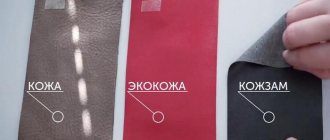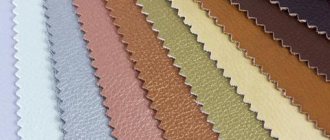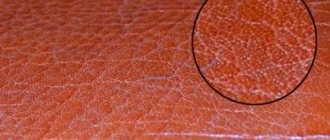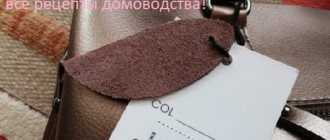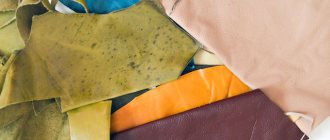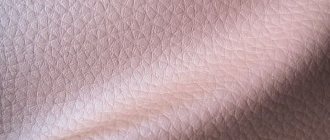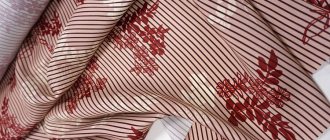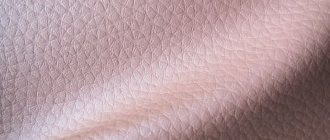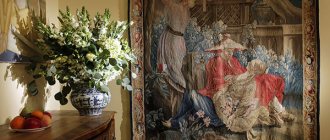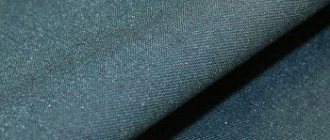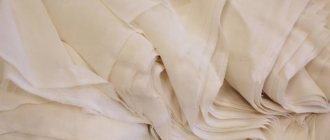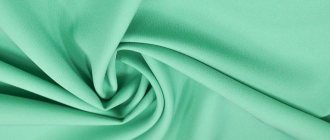Thanks to high technologies, it has become possible to use more advanced, high-quality types of artificial leather in the production of various products that are in no way inferior, but even in some cases superior in properties to natural leather.
Depending on the use of polymer composite materials, which are applied to a woven or non-woven base, artificial leather is divided into the following types: MF microfiber, PU polyurethane, fabric-based PVC (PVC), eco-leather, rubber, polyacetate (PA). Let's look at them in more detail.
What is artificial leather made of and types?
There are many technologies for making leather fabric. The most common are:
- The direct method is to apply a polymer coating to a textile base (smooth synthetic leather - dermantin or synthetics).
- Calender method - applying a textured polymer pattern to a base (allows you to imitate any material).
- Transfer method - a layer of polymer is applied to a paper base that has a relief pattern, then a fabric backing is applied, then the paper is removed, and when drying the layers are fastened together.
- Laminating is gluing an artificial material with a certain texture, for example, wood, onto a fabric or paper base.
- Lamination - covering a textile material with a synthetic film that completely repels water.
Roll of eco-leather
The basis of artificial leather can be fabric or non-woven materials.
Types of leatherette or artificial leather fabric:
- polyurethane PU;
- microfiber;
- PVC on fabric base;
- eco leather;
- rubber;
- polyacetate PA.
Laminating process
Rubber
Rubber, obtained from the sap of the Hevea tree, was the first to be used for the production of synthetic leather. To do this, the shoe material was impregnated with a rubber compound, as a result of which it did not allow water to pass through. Now rubber is used to make individual elements of shoes; rubber leather is used in cars for covering torpedoes, etc.
Hevea tree sap
Polyurethane
It is made by covering a base of cotton fabric with a layer of high quality polyurethane. Polyurethane gives the leather substitute softness, hygiene, high strength, and at the same time water-repellent and breathable properties. May have different colors and textures.
You might be interested in Details about Pikachu fabric: description of properties
Polyurethane coated fabric
Microfiber
The basis of microfiber is a fabric made of ultra-thin fibers, called microfiber, made from polyamide, polyester, etc. The fabric is treated with Teflon on top and acquires water- and dirt-repellent properties.
Untreated microfiber is capable of absorbing a large amount of moisture and is resistant to wear, so it is widely used as a rag for washing cars, household appliances, etc. When microfiber gets dirty, just rinse and wring it out, it becomes clean.
Ultrafine fiber fabric
Important! Most types of leatherette (including PU polyurethane and microfiber) cannot be dry cleaned, washed, twisted, etc.
Fabric based PVC (PVC)
The type of PVC leather is considered the most common; it is made from polyvinyl chloride with the addition of a special plasticizer and additional components that are applied to the base.
To create the base, knitwear and non-woven materials made from natural or artificial fibers are used, on which the characteristics of the product (extensibility, strength) will directly depend.
To achieve greater elasticity, various synthetic additives are added to the material. PVC leather is much heavier than PU leather and less abrasion resistant. The main advantages are ease of maintenance, durability, resistance to ultraviolet radiation and mold damage.
Tactile properties: we distinguish the type of leatherette by touch
There is a big difference in the feel of skin types. Thus, a rubber leather substitute feels hard to the touch, while tarpaulin is hard and tough. PU polyurethane is soft and lightweight, while PVC is heavier; it feels like artificial leather is, in fact, flexible plastic glued to a fabric base. Microfiber is very soft, feels like natural fabric, and is very lightweight.
They also differ greatly in texture and other indicators. For example, dermantine is smooth but cold to the touch, while microfiber is similar in texture to regular fabric, warm, etc.
Microfiber example
Differences between artificial leather and genuine leather
The differences between leatherette and genuine leather are visible to the naked eye. For example, when a drop of water hits leatherette, the water flows off (except for microfiber), and on the skin it is absorbed. When burning, leather emits a natural burning odor, while leatherette emits a chemical odor.
Other differences between artificial leather:
- has increased wear resistance and elasticity;
- cold to the touch, when you apply your hand the palm becomes foggy;
- always looks thinner than real leather;
- some types have a chemical smell;
- from the inside, the base material is often (not always) visible - textile or non-woven material;
- the warp fibers are visible on the cut;
- When heated, most fabrics begin to melt, and after a while natural leather simply catches fire.
Natural material
Please note! It is impossible to check most of these signs in a store. No one will allow you to burn, cut, or turn products inside out. Therefore, it is necessary to pay attention to GOST and other information indicated on the product tag.
Rules of care
If you adhere to certain rules for furniture maintenance, the products will retain their original appearance for a long time:
- constant dry cleaning is carried out using a vacuum cleaner;
- To remove stains, use a damp cloth (soft sponge) and soap foam. After removing dirt, the surface is wiped dry;
- To remove traces of ballpoint pens, felt-tip pens, and lipstick, the area is treated with a 10% alcohol solution. Then use a napkin soaked in water and wipe dry;
- Products with artificial leather upholstery should be placed away from sources of open fire and heating appliances. The canvas is flammable, and can crack due to constant elevated temperatures.
The undoubted advantage of artificial leather for furniture is its practicality and versatility in use.
You can use a soap solution to clean furniture
Benefits of artificial leather for door and furniture upholstery
When upholstering furniture and doors, natural leather is now practically not used; it has been completely replaced by artificial leather, the main advantage of which is that it is not afraid of any pests, for example, moths, etc.
You might be interested in what organza fabric is: appearance and properties
The door, upholstered in modern leather fabrics, looks solid and beautiful. Even the thesis that dermantin is outdated is now untenable, since there are several new types produced according to the new GOSTs, in which the previous shortcomings are negated.
Eco-leather door
In addition to dermantine, there are a lot of new modern materials with different properties. So, the advantages of synthetic leather:
- has good heat and sound insulation;
- resistant to temperature changes;
- resistant to moisture, does not get wet or stretch;
- you can match the color and texture to the door, walls;
- ease of care, low cost.
Furniture covered with leather is virtually no different from models made of genuine leather, but has a number of advantages:
- many colors, patterns;
- resistant to wear and tear, has high ductility;
- several times cheaper than genuine leather;
- resistant to moisture, does not rot, does not stain;
- does not emit harmful secretions, is hygroscopic;
- you can choose the color and texture;
- does not require careful care like natural leather.
Scope of application
PU leather is used to produce:
- bags, backpacks, suitcases;
- clothes and shoes, individual parts;
- wallets, purses, cases, gloves and belts;
- furniture and car upholstery;
- sporting goods - balls, knee pads, gloves, etc.
A noble appearance and affordable price are absolute advantages for clothes and shoes made of polyurethane, but there are also disadvantages. It is impossible to get rid of scratches on such products, and in cold weather they are less comfortable. Therefore, it is better to know what the differences are between this material.
Tag: will it tell you everything about the purchase?
The product tag will not tell anything to an unprepared buyer, so you can only rely on a consultant. In this case, there is a danger that the consultant will “sell” a product that he must sell, but it is not suitable. To intelligently choose a product, you need to have at least a minimum of knowledge about the information contained in the tag, then you can get enough information. What do you need to know?
Shoe tag
- Check GOST. It is necessary to clarify the technology and type of leatherette. For example, GOST 24220-80 defines the characteristics of furniture fabric, and additional marking with the “N” sign means that the furniture fabric is of improved quality.
- A very important indicator of OKPD, that is, an all-Russian classifier of products by type. For example, OKPD 36.11.11.360 - soft (upholstered) seating furniture. OKPD indicates the area of application of a particular leatherette.
Upholstered furniture
Reviews
Andrey Nikolaev, 25 years old, Rostov-on-Don: “We live in a private house, which we inherited from our parents. The front door was old and did not hold heat well. I bought a door upholstery kit at a furniture store, which included dermantin, insulation, and furniture nails, and I upholstered the door myself, fortunately, it’s not difficult. The door simply transformed, became as good as new in appearance, but at the same time stopped letting the cold in. The repair was much cheaper than a new door.”
You might be interested in what Tencel is: a description of the composition of the fabric and the use of the material
Georgy Volgin, 35 years old, Magnitogorsk: “I decided to update the furniture; for the upholstery I chose PU leatherette. This material is very durable, beautiful, and pleasant to the touch. After upholstery, the furniture became like new, and at the same time the price was very reasonable. I am very pleased with the result, the price-quality ratio is excellent.”
Variety of colors
So, synthetic leather, what is it? This is a material invented to improve the specific consumer properties of fabric, as well as to reduce the cost of products by replacing expensive natural material. This material has now almost replaced natural eco-leather, replacing it with a durable and much cheaper artificial material - synthetic.
Let's sum it up
Of course, eco-leather is much better than leatherette and surpasses it in many properties. However, you should not retire leatherette; due to its low cost, this material will remain relevant for a long time and will be in demand on the market.
For example, a person very often changes bags or some items of clothing. In this case, leatherette is ideal - why spend a huge amount of money every season if next season you want to change your look, and for this you are going to completely change your wardrobe. Although you shouldn’t follow fashion so blindly - quality things have always remained a priority and have always been fashion trends in any season.
Each reader will decide for himself what is better for him - artificial or ecological leather. We hope that this article will help you make the right choice so that you enjoy not only the optimal purchase price, but also unsurpassed quality.
Types of eco-leather
What is better: Alcantara or eco-leather?
